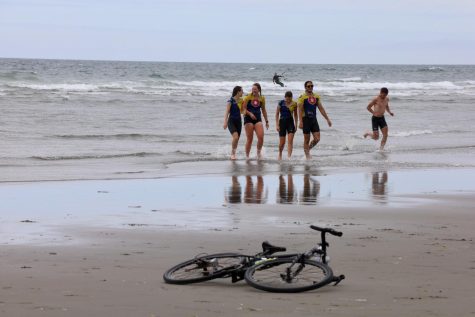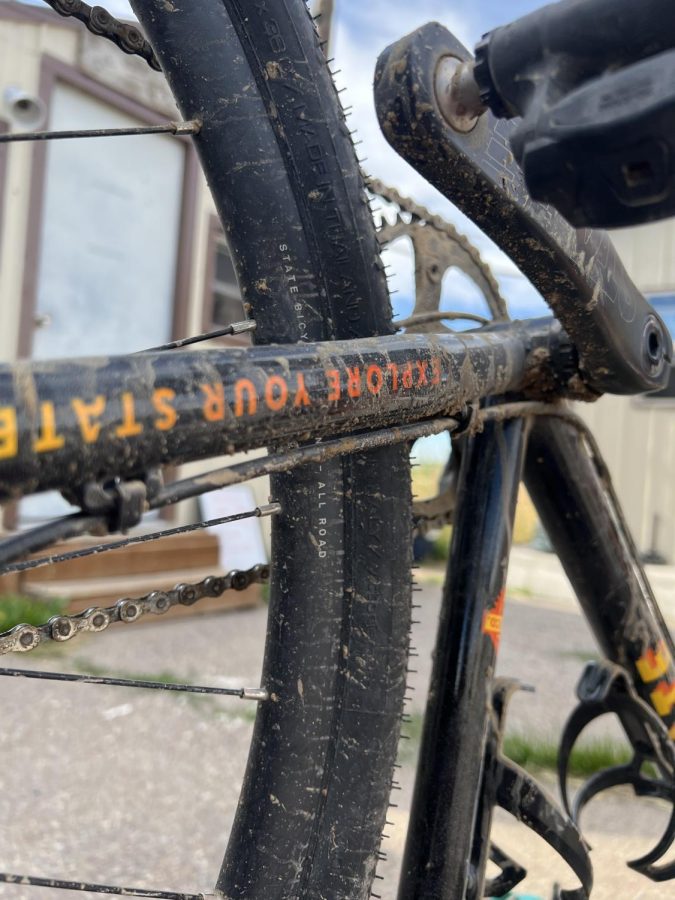Resource Guide: Boston Biking for Students
You don’t need a fancy bike to get around in the city, you just need a safe one.
October 11, 2022
This past summer, I biked across the country for affordable housing, primarily on the Trans-Am bike route. During the hundreds of hours and thousands of miles I spent on my bike, I found there were a handful of things that helped me stay safe and confident on the road, no matter what city or town I was passing through. These seven lessons and safety tips have made me a much better city biker back in Boston. Happy trails!
1. Wear your helmet.
This may seem like a no-brainer, but I can tell you both from my daily commute to Simmons and from the fellow Trans-Am riders I met this summer that it is not. The two best types of helmets on the market right now are MIPS (Multi-directional Impact Protection System) and WaveCel––they can get pretty pricey, but not nearly as expensive as hospital bills. You only get one brain, protect it!
2. Learn some easy hand signals.
Your primary mode of communication between you, cars, and fellow riders on the road is your use of hand signals. The three primary signals, left turn, right turn, and stopping, are a great start. Taking a hand off of your handlebars can be scary the first few times you do it, so I practiced my signals on bike trails before hitting the road. There are plenty of trails near Simmons, but my favorites are Paul Dudley White and Boston City View. If you are riding with other people, feel free to add additional signals to make sure you’re all on the same page. And always call “on your left” when you’re passing another cyclist on the road or bike trail!
3. Act like a car.
The easiest way for Boston drivers to predict how you will move on your bike is by following the same laws they do. In practice, this means paying attention to traffic lights and stop signs, signally your turns, and most importantly, staying off your phone. Biking with your phone out is still distracted driving––if you need directions, pull over or try using a cue sheet! Do your best to never yell at cars, though, even if they yell at you. They’re much bigger than you.

4. Take up space.
As a biker, you are legally entitled to the full lane of any road at any time, even if there is a bike lane. That doesn’t always mean it’s a good idea, though. Especially in high-traffic areas like Fenway-Longwood, drivers can get pretty impatient. I’ve found that I am the safest riding in the right third of the road so that a car has to consciously move over to pass me, but there is still enough room for them to do so. And of course, if the bike lane looks safe, that’s a great option too.
5. Be visible.
Another easy way to make sure cars are paying attention to you is to use bike lights. While both front and back lights are required by law when biking at night, they’re crucial in the daytime too. Your bike lights should be day-rated, meaning their light output suffices to promote visibility in the sun. I use Bontrager Ion 200s––again, they’re pretty pricey, but their battery life is very good, and I’ve used the same pair for two years with no issues. Your white light goes in the front and the red in the back, and both should be set to a blinking setting when you are riding.
6. Learn basic bike maintenance.
You don’t need a fancy bike to get around in the city, you just need a safe one. More affordable commuter bikes, monthly Blue Bike rentals, and the highest quality racing bikes have one big thing in common––neither will work properly if you don’t take care of them. I think the most important and practical skills to get a hold of before hitting the pavement are learning how to change your tire and how to maintain basic chain care. Before every few rides, do a quick once-over of your bike to check your ABCs (air in your tires, chain, and brakes).
7. Trust your gut!
By far the most important thing I learned biking across the country was to trust myself. If you feel uncomfortable on the road, get off. It is so, so much better to be late to a commitment than to get hurt on your bike. As you get more experience on your bike, the times you feel scared or uneasy come less and less often, but it still happens. And that’s okay! The subway system in Boston allows bikes with the exception of the Green Line, and all buses allow bikes on their front rack. Worse comes to worst, most large Ubers or Lyfts accommodate bikes. It is always better to be safe and put out a couple of dollars than in a bad situation.
The best part of city biking––and all biking––isn’t the easier commute or even the greener method of transportation. It’s flying down the road on a sunny day and feeling like you could take off at any minute. It’s pumping up a hill until you think your legs can’t handle a single extra pedal, and then they do. It’s being free! Above any safety tip I can give you, I hope you never lose sight of how simply beautiful it is to have the privilege of seeing the world on two wheels.










Joanne • Oct 11, 2022 at 9:19 pm
Wow, Liv! What great biking thoughts and what great writing! After reading this article, I so want to jump on my bike and feel the freedom and the air. Thank you for this!